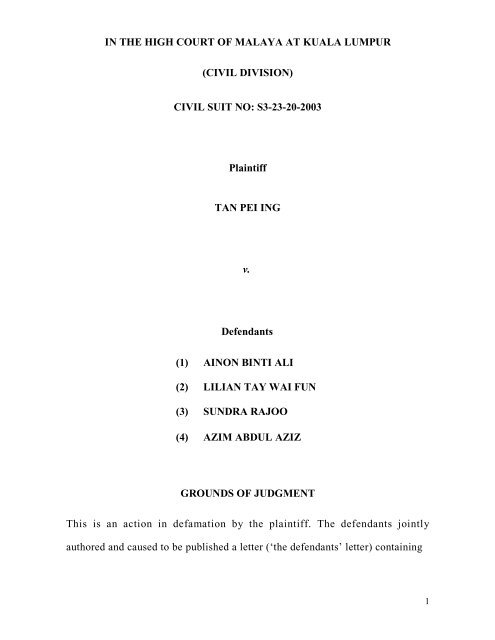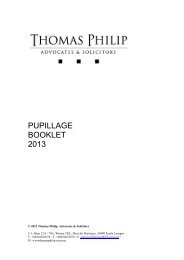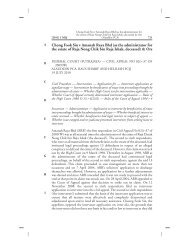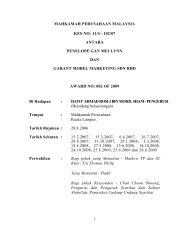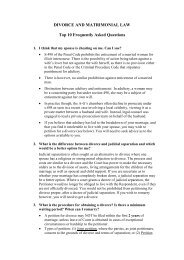IN THE HIGH COURT OF MALAYA AT KUALA LUMPUR (CIVIL ...
IN THE HIGH COURT OF MALAYA AT KUALA LUMPUR (CIVIL ...
IN THE HIGH COURT OF MALAYA AT KUALA LUMPUR (CIVIL ...
Create successful ePaper yourself
Turn your PDF publications into a flip-book with our unique Google optimized e-Paper software.
<strong>IN</strong> <strong>THE</strong> <strong>HIGH</strong> <strong>COURT</strong> <strong>OF</strong> <strong>MALAYA</strong> <strong>AT</strong> <strong>KUALA</strong> <strong>LUMPUR</strong><br />
(<strong>CIVIL</strong> DIVISION)<br />
<strong>CIVIL</strong> SUIT NO: S3-23-20-2003<br />
Plaintiff<br />
TAN PEI <strong>IN</strong>G<br />
v.<br />
Defendants<br />
(1) A<strong>IN</strong>ON B<strong>IN</strong>TI ALI<br />
(2) LILIAN TAY WAI FUN<br />
(3) SUNDRA RAJOO<br />
(4) AZIM ABDUL AZIZ<br />
GROUNDS <strong>OF</strong> JUDGMENT<br />
This is an action in defamation by the plaintiff. The defendants jointly<br />
authored and caused to be published a letter (‘the defendants’ letter) containing<br />
1
statements which the plaintiff claims are defamatory. The plaintiff seeks<br />
damages and an injunction to restrain the defendants from further publishing the<br />
impugned letter.<br />
The plaintiff is a well known architect of standing in Malaysia. At the date of<br />
filing the claim, and at all material times, the plaintiff was the President of<br />
Pertubuhan Architect Malaysia (‘PAM’).<br />
The defendants are architects and are members of PAM, and at the material time<br />
were standing for PAM elections to become members of the PAM Council.<br />
Sometime prior to the elections, the plaintiff, on or around 15 August 2002,<br />
issued and circulated a letter in which she declared her support for 10 out of the<br />
14 candidates running for the PAM elections. Her letter reads -<br />
I hope you will support the following candidates for Council as I believe that these<br />
candidates will be able to serve the institute and work with the office bearers as a<br />
team to continue the objectives established during the last Council year.<br />
2
The defendants were the 4 candidates that were omitted from the list of<br />
candidates she supported. At that point in time, the plaintiff was President of the<br />
outgoing council and was aware of her being returned unopposed as President<br />
for the incoming council.<br />
The defendants took exception and lodged a complaint by way of a letter dated<br />
19 August 2002 (‘the defendants’ letter’) with the election officer.<br />
The contents of the defendants’ letter are reproduced below:<br />
We, the undersigned refer to the enclosed document from “Pei Ing”, the contents of<br />
which are calculated to influence PAM members by canvassing support for the 10<br />
persons named therein for election to PAM Council.<br />
The writer suggests that these 10 (ten) persons named therein would be the only<br />
appropriate persons who “will be able to serve the institute and work with the office<br />
bearers as a team to continue the objectives established during the last Council year”.<br />
In naming the 10 persons for the ten (10) PAM Council positions, the author of this<br />
document has excluded from her list, the other candidates contesting for PAM<br />
Council, this document has been widely circulated to members at large. It is common<br />
3
knowledge among these voting members, that the author is the President of PAM, Tan<br />
Pei Ing.<br />
Given the fact that Tan Pei Ing, the writer of this document is the President of PAM,<br />
we consider that such partisan canvassing of support by the President of PAM would<br />
work a grave injustice to the other candidates contesting for PAM Council positions.<br />
We also question if this a proper use of the influence and position of PAM President<br />
from whom is required due fairness and impartiality in the election process. We<br />
further ask if such conduct by the President of PAM which may be construed as<br />
unethical and unfair, may have compromised this elections and render it invalid.<br />
Under the circumstances, we being the other candidates excluded from the list of the<br />
PAM President, would state that the elections cannot be construed to be fair both in<br />
procedure and in substance. Accordingly, we jointly lodge this protest to the Election<br />
Officer and request for you to cause a retraction of the said letter from Tan Pei Ing to<br />
be sent out immediately to all Corporate Members to ensure fairness and equitable<br />
treatment for all candidates in this PAM elections.<br />
Additionally, we believe the due process of fair elections shall require you to initiate<br />
the appropriate action against the author of this document who while being President<br />
of PAM has caused this document canvassing support to be circulated among the<br />
voting members of PAM.<br />
Given the urgency of this situation with the AGM to he held within 6 days, we trust<br />
that the Election Officer shall act immediately to rectify the situation and ensure<br />
proper procedures and fair contest are upheld in our PAM elections.<br />
4
Contemporaneously, the defendants circulated their letter to the corporate<br />
members of PAM. This was done prior to the election officer having made a<br />
decision on the complaint.<br />
The election officer had, in effect, decided on 22 August 2002 that the note of<br />
support was not cause for concern. In a subsequent letter of 27 August 2002, the<br />
election officer classified the note of support as campaign literature and found<br />
no fault with it. In his evidence the election officer said that the issuance of the<br />
letter of support was not in breach of the PAM constitution.<br />
The plaintiff does not take issue with the issuance of the defendants’ letter to the<br />
election officer. The plaintiff, however, takes issue with the circulation of the<br />
defendants’ letter to the corporate members. It is this publication that the<br />
plaintiff alleges is defamatory.<br />
The plaintiff pleads that the defendants’ letter, in their natural and ordinary<br />
meaning, were and are understood to mean that the plaintiff:<br />
5
(i) was a person who would misuse a position of responsibility and/or the<br />
influence and power arising from such position to her own end;<br />
and/or<br />
(ii) was as such not fit to be an office bearer of PAM.<br />
It is further submitted by the plaintiff that the impugned letter was accusatory<br />
and aggressive in its suggestion that the plaintiff had acted unethically and<br />
unfairly such that a reader might form the view that the suggestion was in fact<br />
the reality.<br />
I have dismissed the plaintiff’s claim with costs.<br />
In my judgment, the defendants’ letter was merely a response to the plaintiff’s<br />
letter. It is in this context that the defendants’ letter must be judged. In my view,<br />
if the defendants’ letter is judged as such, it is nothing more but a legitimate<br />
letter of complaint to an appropriate authority - the election officer. One may<br />
not necessarily agree with the merit of the complaint. But, in my opinion, from<br />
6
its tenor the defendants’ letter expresses a geniuine concern on the part of the<br />
defendants and were issued and circulated in good faith. I do not think that the<br />
defendants, in lodging their complaint to the election officer, had gone over<br />
board. To my mind, the defendants were at liberty to complain to the election<br />
officer in as much as the plaintiff was free to convass for the 10 candidates. The<br />
whole episode must be viewed in its proper perspective, that is to say, in the<br />
context of an ongoing election of the office bearers of PAM; and one must<br />
always be mindful of the fundamental rights to freedom of expression and<br />
freedom of association of the PAM members as enshrined in the Federal<br />
Constitution. I think it is rather far-fetched for the plaintiff to assert that the<br />
defendants” letter will give any reasonable person who reads it the impression<br />
that the plaintiff personally benefited from circulating the plaintiffs letter or that<br />
she is unfit to be an office bearer of PAM. To my mind just as there is nothing<br />
unethical about the plaintiff’s letter canvassing for the 10 candidates, equally,<br />
there is nothing wrong or sinister or defamatory about the defendants’ letter. It is<br />
stretching the interpretation of the contents of the defendants’ letter rather a little<br />
too far to claim that the letter suggests that the plaintiff used her power as<br />
President for her own end or to claim that the letter questions her fitness for<br />
office.<br />
7
The law of defamation is meant to protect the reasonable man, not the overly<br />
sensitive individual.<br />
Accordingly, the action must be dismissed with costs.<br />
[Plaintiff’s claim dismissed with costs.]<br />
(Dato’ Mohd Hishamudin bin Mohd Yunus)<br />
Judge, High Court<br />
(Civil Division)<br />
Kuala Lumpur<br />
Date of decision: 6 January 2009<br />
Date of written grounds of judgment: 21 January 2009<br />
8
Encik Malik Imtiaz and Cik Asma Mohd Yunus (Messrs Thomas Philip) for the<br />
plaintiff<br />
Encik Sri Dev Nair and Encik Yusrin Faidz (Messrs Faidz, Leong & Chong) for<br />
the first defendant<br />
Encik Mark Labrooy (Messrs Raja, Dairyl & Loh) for the second defendant<br />
Encik Mahendra Navaratnam and Cik Aida Haryani (Messrs Kadir Andri &<br />
Partners) for the third defendant<br />
Encik Bhag Singh (Messrs Bhag Sulaiman & Co) for the fourth defendant<br />
9


